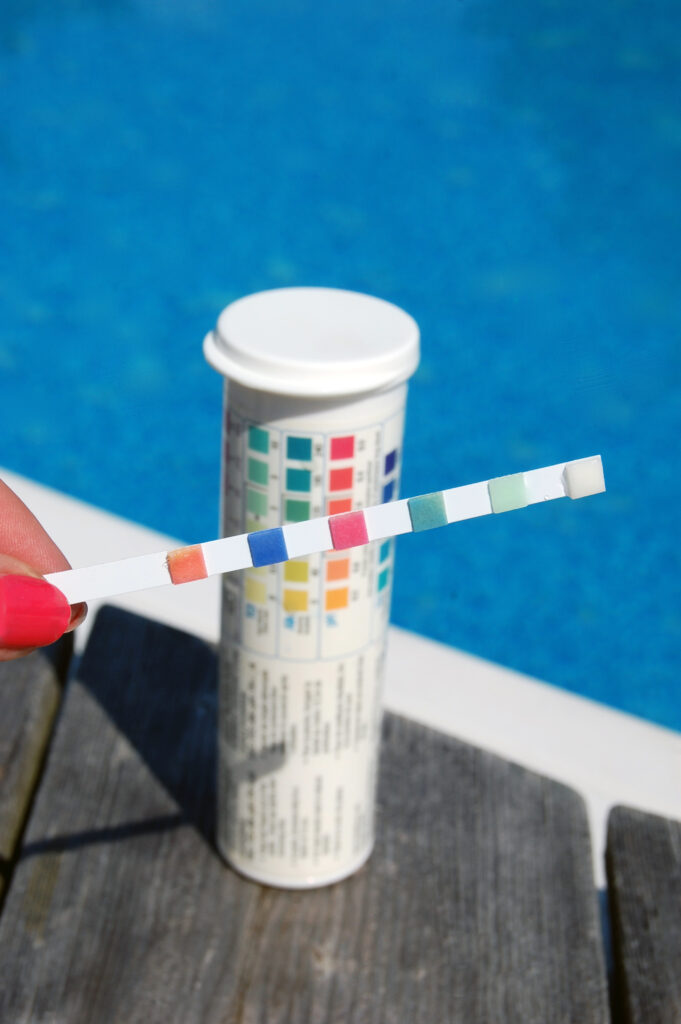What Does Alkalinity Do for a Pool
Let’s delve deeper into the concept of what does alkalinity do for pool water and its significance in pool water chemistry.

Chemical Composition
- Total alkalinity represents the concentration of various alkaline compounds dissolved in the pool water. These compounds primarily include bicarbonates, carbonates, and hydroxides. Other alkaline substances, such as certain types of salts, may also contribute to total alkalinity.
pH Buffering Capacity
- One of the critical functions of total alkalinity is its ability to act as a buffer against pH changes.
- Buffering capacity refers to the water’s resistance to pH fluctuations when acids or bases are added. Total alkalinity helps maintain the pH of the pool water within a stable range, preventing rapid swings that can lead to water imbalances and discomfort for swimmers.
Relationship with pH
- Total alkalinity and pH are closely linked but serve different purposes in pool water chemistry. While total alkalinity stabilizes pH, pH measures the acidity or basicity of the water. Alkalinity levels influence how resistant the water is to changes in pH. Low alkalinity can result in pH instability and rapid fluctuations, while high alkalinity can lead to pH levels creeping upward over time.
Importance of Proper Levels

- Maintaining total alkalinity within the recommended range (typically 80-120 ppm) is crucial for several reasons:
- Prevents pH Fluctuations: Adequate alkalinity prevents rapid changes in pH, which can affect the effectiveness of chlorine and other sanitizers. It provides a cushioning effect, keeping the pH relatively stable despite external influences.
- Protects Equipment and Surfaces: Balanced alkalinity helps protect pool equipment, surfaces, and fixtures from corrosion or scaling caused by aggressive water chemistry. It also reduces the risk of staining on pool walls and floors.
- Enhances Water Clarity and Comfort: Properly balanced alkalinity contributes to crystal clear balanced water that is comfortable for swimmers. It prevents cloudiness, eye irritation, and skin dryness associated with water that is either too acidic or too basic.
If the alkalinity level falls below 80 ppm, the water becomes too acidic. Conversely, if the alkalinity levels rise above 120 ppm the water becomes too alkaline.
Adjusting Total Alkalinity
- If total alkalinity deviates from the desired range, adjustments may be necessary.
- To raise alkalinity, add alkalinity increasers like sodium bicarbonate (baking soda) to the water. Conversely, to lower alkalinity, use acid-based products such as muriatic acid or sodium bisulfate. Take care when adjusting alkalinity to avoid overshooting the target range and causing further imbalances.
Testing and Monitoring
- Regular testing of total alkalinity is essential to ensure proper water balance and chemistry. Pool owners should use reliable test kits or digital meters to measure alkalinity levels accurately.
- Perform testing at least once a week, or more frequently during periods of heavy pool usage, water treatment, or extreme weather conditions.
By understanding the nuanced role of total alkalinity in pool water chemistry and implementing appropriate maintenance practices, pool owners can achieve balanced, comfortable, and safe swimming environments for their family and friends.